| Vectorial Elevation was first produced in 1999 for the Zócalo Square in Mexico City. It is the fourth piece in the relational architecture series, which now includes eight pieces. Its main objective is to allow public control of the spectacular lighting possible with searchlights, which normally follows a preprogrammed sequence of movements. There is a large number of precedents for this type of work, from installations at World Exhibitions to Fascist spectacles, and many of them are discussed in the Vectorial Elevation book.
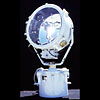 One of the oldest precedents to the teleoperation of light is the Lindbergh Beacon in Los Angeles, which was first illuminated in 1928 when president Coolidge activated it by pressing a telegraph key from his desk at the White House. Here are a few recent artworks to which the project can be directly associated: One of the oldest precedents to the teleoperation of light is the Lindbergh Beacon in Los Angeles, which was first illuminated in 1928 when president Coolidge activated it by pressing a telegraph key from his desk at the White House. Here are a few recent artworks to which the project can be directly associated:
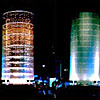 Toyo Ito’s interactive architecture, such as his 1986 Tower of Winds in Yokohama, which transforms on environmental changes such as noises and the speed and direction of the wind. Toyo Ito’s interactive architecture, such as his 1986 Tower of Winds in Yokohama, which transforms on environmental changes such as noises and the speed and direction of the wind.
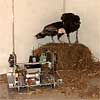 Ornitorrinco the telerobot by Eduardo Kac and Ed Bennett (1989), which was a first contact with the prolific field of artistic teleoperation. Ornitorrinco the telerobot by Eduardo Kac and Ed Bennett (1989), which was a first contact with the prolific field of artistic teleoperation.
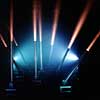 Louis Phillippe Demers and Bill Vorn's 1993 installation Espace Vectoriel, where the presence of the public triggered motion patterns and sounds from robotic light assemblies. Louis Phillippe Demers and Bill Vorn's 1993 installation Espace Vectoriel, where the presence of the public triggered motion patterns and sounds from robotic light assemblies.
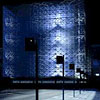 Christian Möller and Joachim Sauter’s 1994 Networked Skin project for the Ars Electronica Center, designed to transform the building with a global interface. Christian Möller and Joachim Sauter’s 1994 Networked Skin project for the Ars Electronica Center, designed to transform the building with a global interface.
 Rafael Lozano-Hemmer and Will Bauer's 1995 installation The Trace, where two remote participants shared the same telematic space constructed with intersecting light beams. Rafael Lozano-Hemmer and Will Bauer's 1995 installation The Trace, where two remote participants shared the same telematic space constructed with intersecting light beams.
 Knowbotic Research 1996-97 Anonymus Muttering, featuring real time intersection of net data with sound and light transformation. Knowbotic Research 1996-97 Anonymus Muttering, featuring real time intersection of net data with sound and light transformation.
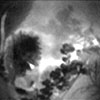 Ken Goldberg's telepresence pieces, such as his Dislocation of Intimacy which allows participants on the web to turn lights on and off and watch the shadows produced by an offscreen installation.
Ken Goldberg's telepresence pieces, such as his Dislocation of Intimacy which allows participants on the web to turn lights on and off and watch the shadows produced by an offscreen installation.
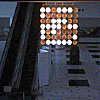 Masaki Fujihata's, Light on the Net Project, a piece that allows turning individual lightbulbs on a display in Tokyo. Masaki Fujihata's, Light on the Net Project, a piece that allows turning individual lightbulbs on a display in Tokyo.
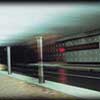 Hans Muller and Zwarts / Jansma Architecten 1998 installation in the Leidschenveen Tunnel, which allows people to send messages over the net, which are then presented in an electronic display in public space. Hans Muller and Zwarts / Jansma Architecten 1998 installation in the Leidschenveen Tunnel, which allows people to send messages over the net, which are then presented in an electronic display in public space.
 Stadtwerkstatt's Clickspace 98, a three module project that allowed light, sounds and messages to be displayed in various buildings in Linz, Austria. Stadtwerkstatt's Clickspace 98, a three module project that allowed light, sounds and messages to be displayed in various buildings in Linz, Austria.
 Johannes Gees' Hello Mr. President, a laser text display on the mountain side in Davos, Switzerland, allowed projection of texts which might be read by otherwise unreachable corporate and political leaders, meeting in January of 2001. Johannes Gees' Hello Mr. President, a laser text display on the mountain side in Davos, Switzerland, allowed projection of texts which might be read by otherwise unreachable corporate and political leaders, meeting in January of 2001.
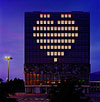 Chaos Computer Club's Blinkenlights project in Berlin, which transformed an office building into a popular display of messages an animation through an elegant interface. Chaos Computer Club's Blinkenlights project in Berlin, which transformed an office building into a popular display of messages an animation through an elegant interface.
More information regarding other projects by Lozano-Hemmer can be found in his web site www.lozano-hemmer.com.
|
 Toyo Ito’s interactive architecture, such as his 1986 Tower of Winds in Yokohama, which transforms on environmental changes such as noises and the speed and direction of the wind.
Toyo Ito’s interactive architecture, such as his 1986 Tower of Winds in Yokohama, which transforms on environmental changes such as noises and the speed and direction of the wind.

 Christian Möller and Joachim Sauter’s 1994
Christian Möller and Joachim Sauter’s 1994  Rafael Lozano-Hemmer and Will Bauer's 1995 installation
Rafael Lozano-Hemmer and Will Bauer's 1995 installation  Knowbotic Research 1996-97
Knowbotic Research 1996-97  Ken Goldberg's telepresence pieces, such as his
Ken Goldberg's telepresence pieces, such as his  Masaki Fujihata's,
Masaki Fujihata's,  Hans Muller and Zwarts / Jansma Architecten 1998 installation in the
Hans Muller and Zwarts / Jansma Architecten 1998 installation in the  Stadtwerkstatt's
Stadtwerkstatt's  Johannes Gees'
Johannes Gees'  Chaos Computer Club's
Chaos Computer Club's